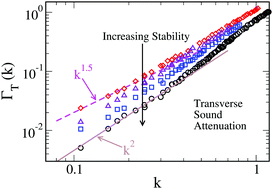Sound attenuation in finite-temperature stable glasses
Abstract
The temperature dependence of the thermal conductivity of amorphous solids is markedly different from that of their crystalline counterparts, but exhibits universal behaviour. Sound attenuation is believed to be related to this universal behaviour. Recent computer simulations demonstrated that in the harmonic approximation sound attenuation Γ obeys quartic, Rayleigh scattering scaling for small wavevectors k and quadratic scaling for wavevectors above the Ioffe–Regel limit. However, simulations and experiments do not provide a clear picture of what to expect at finite temperatures where anharmonic effects become relevant. Here we study sound attenuation at finite temperatures for model glasses of various stability, from unstable glasses that exhibit rapid aging to glasses whose stability is equal to those created in laboratory experiments. We find several scaling laws depending on the temperature and stability of the glass. First, we find the large wavevector quadratic scaling to be unchanged at all temperatures. Second, we find that at small wavevectors Γ ∼ k1.5 for an aging glass, but Γ ∼ k2 when the glass does not age on the timescale of the calculation. For our most stable glass, we find that Γ ∼ k2 at small wavevectors, then a crossover to Rayleigh scattering scaling Γ ∼ k4, followed by another crossover to the quadratic scaling at large wavevectors. Our computational observation of this quadratic behavior reconciles simulation, theory and experiment, and will advance the understanding of the temperature dependence of thermal conductivity of glasses.



 Please wait while we load your content...
Please wait while we load your content...
